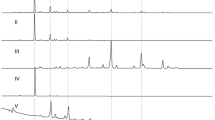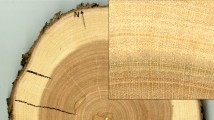Abstract
The cell wall chemistry (amount of hemicellulose, α-cellulose, and total lignin) and the concentration of extractives (total acetone-soluble extractives, resin acids, pinosylvins and the total phenolics quantified as tannin acid equivalents) were studied in brown-rot resistant and susceptible juvenile heartwood of Scots pine (Pinus sylvestris L.). The study material consisted of a total of 18 trees from two 34-year-old progeny trials at Korpilahti and Kerimäki. The trees were selected from among 783 trees whose decay rate had previously been screened in a laboratory test using a brown-rot fungus, Coniophora puteana. Samples from neither location showed any significant difference in the concentration (mg/cm3) of hemicellulose, α-cellulose and total lignin between the decay resistant and susceptible trees. At both locations only the concentration of total phenolics was higher in the decay-resistant heartwood than in the decay-susceptible heartwood. At Korpilahti, the amount of acetone-soluble extractives and the concentration of pinosylvin and its derivatives were higher in the resistant than in the susceptible trees.

Similar content being viewed by others
References
Anonymous (1996) SAS/STAT Software: changes and enhancements through release 6.11. SAS Institute, Cary, N.C.
Anttonen S, Manninen A-M, Saranpää P, Kainulainen P, Linder S, Vapaavuori E (2002) Effects of long-term nutrient optimization on stem wood chemistry in Picea abies. Trees 16:386–394
Blumenkranz N, Asboe-Hansen G (1973) New method for quantitative determination of uronic acids. Anal Biochem 54:484–489
EN 113 (1996) European standard. Wood preservatives. Test method for determining the protective effectiveness against wood destroying basidiomycetes; determination of the toxic values. European Committee for Standardization, Brussels
Ericsson T, Fries A (1999) High heritability for heartwood in north Swedish Scots pine. Theor Appl Genet 98:732–735
Ericsson T, Fries A, Gref R (2001) Genetic correlations of heartwood extractives in Pinus sylvestris progeny test. For Genet 8:73–80
Fries A, Ericsson T (1998) Genetic parameters in diallel-crossed Scots pine favour heartwood formation breeding objectives. Can J For Res 28:937–941
Fries A, Ericsson T, Gref R (2000) High heritability of wood extractives in Pinus sylvestris progeny tests. Can J For Res 30:1707–1713
Green F III, Larsen MJ, Winandy JE, Highley TL (1991) Role of oxalic acid in incipient brown-rot decay. Mater Org 26:191–213
Hakkila P (1968) Geographical variation of some properties of pine and spruce pulpwood in Finland. Comm Inst For Fenn 66.8:1–160
Harju AM, Venäläinen M (2002) Genetic parameters regarding the resistance of Pinus sylvestris heartwood to decay caused by Coniophora puteana. Scand J For Res 17:199–205
Harju AM, Venäläinen M, Beuker E, Velling P, Viitanen H (2001) Genetic variation in the decay resistance of Scots pine wood against brown rot fungus. Can J For Res 31:1244–1249
Harju AM, Kainulainen P, Venäläinen M, Tiitta M, Viitanen H (2002) Differences in resin acid concentration between brown-rot resistant and susceptible Scots pine heartwood. Holzforschung 56:479–486
Highley TL (1987) Changes in chemical components of hardwood and softwood by brown-rot fungi. Mater Org 22:39–45
Hyde SM, Wood PM (1997) A mechanism for production of hydroxyl radicals by the brown-rot fungus Coniophora puteana: Fe(III) reduction by cellobiose dehydrogenase and FE(II) oxidation at a distance from the hyphae. Microbiology 143:259–266
Julkunen-Tiitto R (1985) Phenolic constituents in the leaves of northern willows: methods for the analysis of certain phenolics. J Agric Food Chem 33:213–217
Kainulainen P, Satka H, Mustaniemi A, Holopainen JK, Oksanen J (1993) Conifer aphids in an air-polluted environment. II. Host plant quality. Environ Pollut 80:193–200
KCL (1982) Massan ja puun kokonaisligniinipitoisuus (in Finnish). Central Laboratory of Finland, Espoo, Finland
Manninen A-M, Tarhanen S, Vuorinen M, Kainulainen P (2002) Comparing the variation of needle and wood terpenoids in Scots pine provenances. J Chem Ecol 28:211–228
Merrill W (1992) Mechanism of resistance to fungi in woody plants: a historical perspective. In: Blanchette RA, Biggs AR (eds) Defense mechanisms of woody plants against fungi. Springer, Berlin Heidelberg New York, pp 1–12
Morrell JJ, Gartner BL (1998) Wood as a material. In: Bruce A, Palfreyman JW (eds) Forest products biotechnology. Taylor and Francis, London, pp 1–14
Panshin AJ, de Zeeuw C (1980) Textbook of wood technology, 4th edn. McGraw-Hill, New York
Rättö M, Ritschkoff A-C, Viikari L (1997) The effect of oxidative pretreatment on cellulose degradation by Poria placenta and Trichoderma reesei cellulases. Appl Microbiol Biotechnol 48:53–57
Rayner ADM, Boddy L (1988) Fungal decomposition of wood; its biology and ecology. Wiley, Portsmouth
Ritschkoff A-C (1996) Decay mechanisms of brown rot fungi. Espoo. VTT Building Technology. Publication 268. VTT, Espoo
Ritschkoff A-C, Buchert J, Viikari L (1992) Identification of carbohydrate degrading enzymes from the brown-rot fungus, Gloeophyllum trabeum. Mater Org 27:19–29
SCAN-CM (1994) Asetoniin liukenevan aineen määrittäminen (in Finnish). Scandinavian pulp, paper and board testing committee 50, Stockholm
Sokal RR, Rohlf FJ (1995) Biometry, 3rd edn. Freeman, New York
Sjöström E (1993) Wood chemistry. Fundamentals and applications, 2nd edn. Academic Press, San Diego, California
Updegraff DM (1969) Semi-micro determination of cellulose in biological materials. Anal Biochem 32:420–424
Van Acker J, Militz H, Stevens M (1999) The significance of accelerated laboratory testing methods determining the natural durability of wood. Holzforschung 53:449–458
Vance CP, Kirk TK, Sherwood RT (1980) Lignification as a mechanism of disease resistance. Annu Rev Phytopathol 18:259–288
Venäläinen M, Harju A, Nikkanen T, Paajanen L, Velling P, Viitanen H (2001) Genetic variation in the decay resistance of Siberian larch (Larix sibirica Ledeb.) wood. Holzforschung 55:1–6
Venäläinen M, Harju A, Saranpää P, Kainulainen P, Tiitta M, Velling P (2003) The concentration of phenolics in brown-rot decay resistant and susceptible Scots pine heartwood. Wood Sci Technol (in press)
Viitanen H (1996) Factors affecting the development of mould and brown rot decay in wooden material and wooden structures. Effect of humidity, temperature and exposure time. Dissertation. The Swedish University of Agricultural Sciences, Department of Forest Products, Uppsala
Viitanen H, Ritschkoff A-C (1991) Brown rot decay in wooden constructions. Effect of temperature, humidity and moisture. Report No 222. Swedish University of Agricultural Sciences, Department of Forest Products, Uppsala
Viitanen H, Paajanen L Nikkanen T, Velling P (1998) Decay resistance of Siberian larch wood against brown rot fungi. 2. The effect of genetic variation. IRG Doc. No: IRG/WP 98–10287. The International Research Group on Wood Preservation, Stockholm
Walker JCF (1993) Primary wood processing: principles and practice. Chapman and Hall, London
Wazny J, Greaves H (1984) A comparison of fungal strains used in the bioessay of wood preservatives. Doc. no 2220. International Research Group on Wood Preservatives, Stockholm
Winandy JE, Morrell JJ (1993) Relationship between incipient decay, strength, and chemical composition of Douglas-fir heartwood. Wood Fiber Sci 25:278–288
Zabel RA, Morrell JJ (1992) Wood Microbiology: decay and its prevention. Academic Press, California
Acknowledgements
We are grateful to Heikki Kinnunen, Eija Matikainen, Teemu Moilanen, Heikki Paajanen, Tarja Salminen, and Jussi Tiainen from the Punkaharju Research Station for sampling and measuring the increment cores. Liisa Seppänen carried out the decay test in the laboratory of VTT Building and Transport, Terhi Vuorinen analysed the resin acids and total phenolics in Kuopio, and Tapio Laakso and Veikko Kitunen carried out the GLC-MS analyses in Vantaa. We thank them all and the personnel of the Suonenjoki Research Station for their contribution, as well as John Derome for checking the language. The Academy of Finland (Resource Council for the Environment and Natural Resources, projects No. 43140 and 43159) supported this study, which belongs to the Finnish Forest Cluster Research Programme WOOD WISDOM (1998–2001).
Author information
Authors and Affiliations
Corresponding author
Rights and permissions
About this article
Cite this article
Harju, A.M., Venäläinen, M., Anttonen, S. et al. Chemical factors affecting the brown-rot decay resistance of Scots pine heartwood. Trees 17, 263–268 (2003). https://doi.org/10.1007/s00468-002-0233-z
Received:
Accepted:
Published:
Issue Date:
DOI: https://doi.org/10.1007/s00468-002-0233-z




